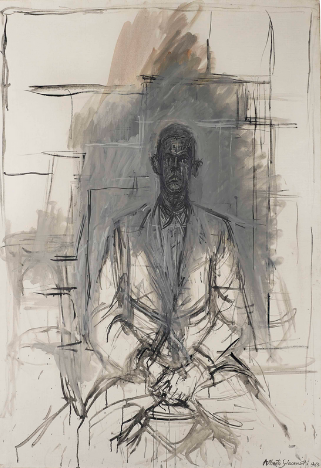|
In 2017, I visited the Giacometti exhibition at the National Art Museum in Tokyo. The show concentrated on the sculpture, but there were also a number of drawings, which I loved, and a couple of paintings. The overall impression was of an artist wrestling with the questions of reality and perception. There were no answers, but the sculptures were impressive, and to use a hackneyed term, timeless. Although I was familiar with Giacometti's painted portraits from collections, previous exhibitions (including the 1965 show at London's Tate Gallery), and reproductions, I found that the paintings still puzzled me in ways the sculptures and the drawings did not. I recently watched the movie 'The Final Portrait' with Geoffrey Rush as Giacometti. The film, which I thoroughly enjoyed, led me to read 'A Giacometti Portrait' by James Lord, a short account of Lord's experience of sitting for the artist, and on which the film was based. Giacometti's single-mindedness and constant doubt fascinated me. I then read Lord's biography of the artist, looked at numerous reproductions, and watched as many Giacometti-related videos on YouTube as I could find. Giacometti said that he was trying to paint what he saw and was destined to fail. In a 2016 post, I wrote about the concept of artistic failure and quoted Giacometti: “All I can do will only ever be a faint image of what I see and my success will always be less than my failure or perhaps equal to the failure.” Even though the painted portraits may bear a likeness to the sitters, it is reasonable to assume that the paintings do not closely resemble what was in front of him. Of course, any artist's paintings are interpretations of what is seen, but somehow Giacometti's works seem to consist entirely of the process of interpretation. They are records or traces of how he saw –measuring, adjusting, readjusting, erasing. Colour is virtually absent, as if it would hinder the realization of the solid form of a head or body. In terms of form, his drawings are generally much closer to 'reality' than the paintings. So did the act of painting present particular problems of technique? Or did the paintings attempt something more ambitious, and therefore more difficult? Giacometti's painting can be seen as an extension of the late work of Cézanne (who he greatly admired), but a major difference is the virtual abolition of color in Giacometti's paintings. Even so, there is a clear connection between a typical Giacometti portrait and, say, Cézanne's late frontal portraits of his gardener, Vallier. And is it too much of a stretch to see a connection between Giacometti's mainly monochromatic images and the idea that nothing in the world 'out there' has intrinsic color? The notion that the world is full of colorless objects waiting to be brought to life by the perception of the onlooker?
0 Comments
|

 RSS Feed
RSS Feed